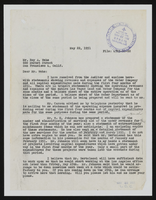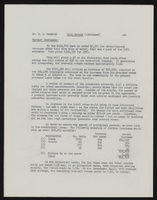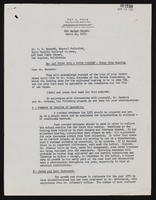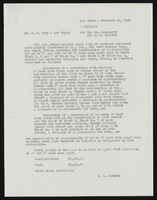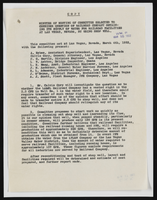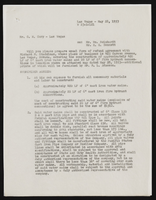Search the Special Collections and Archives Portal
Search Results
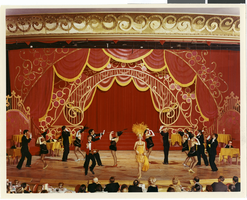
Photograph showing a production of Pzazz! 70 staged by Donn Arden, Desert Inn Hotel, Las Vegas, circa 1970
Date
1969 to 1971
Archival Collection
Description
On a wooden stage decorated with yellow tables and a red and yellow curtain backdrop, entertainers perform Act 9: "Chicago," Scene 2: "Club Royale" of the show Pzazz! 70 staged by Donn Arden at the Desert Inn Hotel, Las Vegas. At the center of the stage stands a female performer clothed in a glittery, yellow dress with a matching yellow feather headpiece. Located to the female's left is a man in mid-step who is dressed as a waiter. He is wearing a red tuxedo, a black bow tie, and is holding a metal serving tray. Dancing on either side of the waiter and central woman are other female and male performers who are paired together in a female-male fashion. The males are wearing black tuxedoes with white gloves as the females are sporting short, black dresses, a matching feathery black headpiece, black tights, and varying colored high heels. A crowd of onlookers enjoy the performance from beneath the stage.
Show Name: Pzazz! 70
Performance Name: Chicago: Club Royale
Show Name: Pzazz! 70
Performance Name: Chicago: Club Royale
Image

Photograph showing a production of Pzazz! 70 staged by Donn Arden, Desert Inn Hotel, Las Vegas, circa 1970
Date
1969 to 1971
Archival Collection
Description
On a wooden stage decorated with a metal structure that provides steps for the performers to stand on, entertainers perform the finale "New York-A Salute to Duke Ellington" of the show Pzazz! 70 staged by Donn Arden at the Desert Inn Hotel, Las Vegas. Standing in the center front of the stage is a male performer dressed in a prison inspired black and white striped costume that shows off his midriff and has white straps for arm sleeves. Surrounding the man are other various male and females also striking poses for the crowd. The other males are dressed in prison inspired orange and black striped costumes, while the females are either sporting one-shouldered, sparkling orange dresses with matching orange feather headpieces, or a two-piece costume made out of mesh covered in sparkling orange beading and with matching orange feather headpieces.
Show Name: Pzazz! 70
Performance Name: New York-A Salute to Duke Ellington
Show Name: Pzazz! 70
Performance Name: New York-A Salute to Duke Ellington
Image
Pagination
Refine my results
Content Type
Creator or Contributor
Subject
Archival Collection
Digital Project
Resource Type
Year
Material Type
Place
Language
Records Classification


